Linear type trait genetic trends in Irish Holstein-Friesian dairy animals
IF 1.4
4区 农林科学
Q3 AGRICULTURE, MULTIDISCIPLINARY
引用次数: 0
Abstract
The objective of the present study was to investigate the genetic trends of 18 subjectively scored linear type traits describing animal morphology, as well as udder, teat, feet and leg conformation. The analysis was undertaken using 2,932,700 Holstein-Friesian females born in the Republic of Ireland between the years 2000 and 2020, inclusive. The results indicate that Holstein-Friesian females have progressively become shorter in stature as well as shallower (i.e. body depth) and less angular. The reduction in genetic merit for stature score since the year 2004 was, however, only observed in non-herdbook-registered heifers. Furthermore, the reducing score in body depth (i.e. narrower) and angularity (i.e. less angular) was approximately twice as fast in non-herdbook-registered heifers as it was in herdbook-registered heifers. Differences in the genetic merit of the body-related traits for calves born versus those that became cows only existed prior to 2010 with little biological differences thereafter; this observation was common across most of the linear type traits. Genetic merit for locomotion in non-herdbook-registered animals has deteriorated over the 20-yr period, while the foot angle over that period is becoming lower; no such trends were observed for the herdbook-registered animals. Large differences not only in the trends themselves, but also in the mean genetic merit for udder traits existed when comparing herdbook-registered calves versus non-registered calves. In conclusion, genetic merit for many of the traits evaluated has trended relatively consistent in a given direction, albeit the cumulative change in genetic s.d. units per traits over the 20-yr period was very small.爱尔兰荷斯坦-弗里斯奶牛线性型性状遗传趋势
本研究的目的是调查描述动物形态的18个主观评分线性型性状的遗传趋势,以及乳房、乳头、脚和腿的构象。该分析使用了2000年至2020年(含)期间出生在爱尔兰共和国的2932700名荷尔斯泰因-弗里斯女性进行。结果表明,荷斯坦-弗里斯坦雌性的身材逐渐变矮,也越来越浅(即身体深度),棱角也越来越小。然而,自2004年以来,只有在非牧民登记的小母牛中才观察到身材得分的遗传优势下降。此外,在非牧民登记的小母牛中,体深(即较窄)和角度(即较低角度)的降低速度大约是牧民登记小母牛的两倍。出生的小牛与成为奶牛的小牛在身体相关性状的遗传优势方面的差异仅在2010年之前存在,此后几乎没有生物学差异;这一观察结果在大多数线性型性状中都很常见。在20年的时间里,非牧民登记动物运动的遗传优势已经恶化,而在这段时间里,脚的角度越来越低;在herdbook登记的动物中没有观察到这种趋势。在比较牧民登记的小牛和未登记的小牛时,不仅在趋势本身,而且在乳房性状的平均遗传价值方面都存在巨大差异。总之,尽管20年来每个性状的遗传s.d.单位的累积变化非常小,但评估的许多性状的遗传价值在特定方向上趋于相对一致。
本文章由计算机程序翻译,如有差异,请以英文原文为准。
求助全文
约1分钟内获得全文
求助全文
来源期刊
CiteScore
2.50
自引率
20.00%
发文量
23
审稿时长
>36 weeks
期刊介绍:
The Irish Journal of Agricultural and Food Research is a peer reviewed open access scientific journal published by Teagasc (Agriculture and Food Development Authority, Ireland). Manuscripts on any aspect of research of direct relevance to Irish agriculture and food production, including plant and animal sciences, food science, agri environmental science, soils, engineering, buildings, economics and sociology, will be considered for publication. The work must demonstrate novelty and relevance to the field of research. Papers published or offered for publication elsewhere will not be considered, but the publication of an abstract does not preclude the publication of the full paper in this journal.

 求助内容:
求助内容: 应助结果提醒方式:
应助结果提醒方式:


